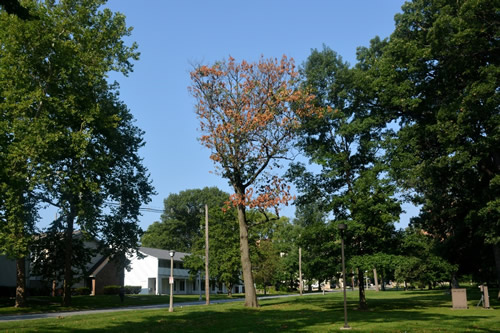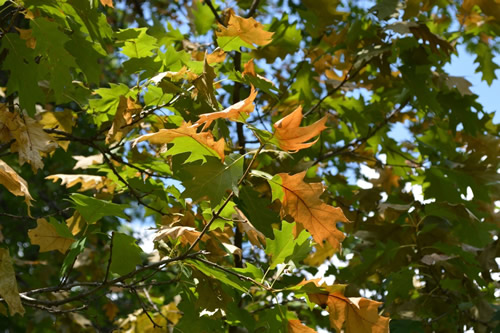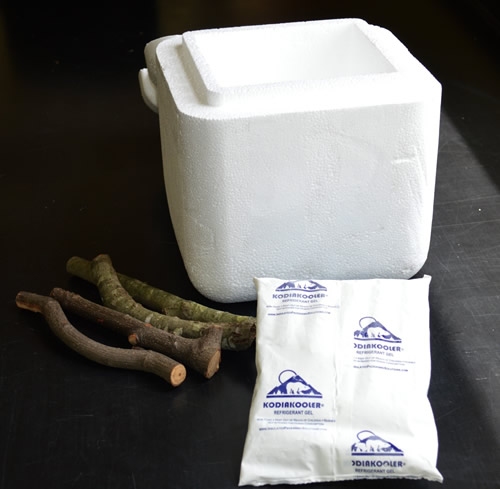Issue 7, July 13, 2020
Oak Wilt
Oak wilt is a serious fungal disease which continues to kill oak trees in residential areas, parks, farm woodlots, and forests throughout Illinois. The oak wilt pathogen was first detected in Wisconsin in 1944 and has slowly spread throughout the central and eastern United States, including Illinois. Oak trees are the only known host. Oaks trees within the red and black group (pointed leaf lobes) are more susceptible than oaks in the white oak group (rounded leaf lobes).

Photo 1. Northern red oak killed by oak wilt
SYMPTOMS
- Red and black oak group (pointed leaf lobes)
- Symptoms first appear at the top of the tree or at the tips of the lateral branches in late spring and early summer.
- Symptomatic leaves curl slightly and turn a dull pale green, bronze, or tan, starting at the leaf margins.
- Infected trees rapidly defoliate. By late summer, an infected tree is often bare of leaves.
- A brown or black discoloration usually develops in the current‐season sapwood of wilting branches.
- Once infected, oaks in the red and black group do not recover.
- White oak group (rounded leaf lobes)
- Symptoms usually appear on scattered branches of the crown, and may be confused with general dieback and decline.
- Leaves on infected white oaks become light brown or straw‐colored from the leaf tip toward the base. Leaves curl, but often remain attached to the branches.
- The trees may die in one year, but usually die slowly over a period of several years or more.

Photo 2. Oak wilt foliar symptoms on northern red oak.
PATHOGEN
Oak wilt is caused by the fungal pathogenBretziella fagacearum, formerly known as Ceratocystis fagacearum. The pathogen moves from diseased to healthy trees in two ways, through root grafts formed naturally between oak trees of the same group and through fresh wounds via sap‐feeding insect vectors. Within a few days of infection, balloon‐like tyloses and gums begin to plug the water conducting tissue within the tree, blocking the flow of water and nutrients from the roots to the foliage. As the supply of water becomes restricted, leaves wilt and die.
DIAGNOSIS
The leaf symptoms associated with oak wilt can easily be confused with other oak pests and disorders. Ideally, a plant diagnostic laboratory should confirm suspected oak wilt infections.
- What to collect for a sample:
- Fresh samples, taken from living, symptomatic branches with the leaves still attached. The pathogen will not survive in dead or dry branches.
- Look for branches with symptoms of vascular streaking. The U of I Plant Clinic is most likely to isolate the pathogen from branches with vascular streaking.
- Sample 1‐2 inches in diameter branches. Plant clinic staff are less likely to isolate the pathogen from small twigs or larger branches.
- How to submit a sample to the University of Illinois Plant Clinic:
- The oak wilt pathogen is intolerant of temperatures above 90°F and is also sensitive to drying and other competing fungi. Exposure to these conditions during shipping may result in an inconclusive diagnosis.
- Mail samples the same day they are collected, or refrigerate and mail them soon after.
- When shipping samples, we recommend using an inexpensive cooler with a disposable ice pack.
- Ship via overnight or next‐day delivery, and avoid shipping late in the week. This will help to prevent samples from being held over the weekend in a hot mail truck.
NOTE (Summer 2020): Packages shipped to the Plant Clinic via USPS are being picked up 3-4 times a week. FedEx packages are picked up as packages arrive, and UPS is delivering packages daily. No matter how you send a sample, we highly recommend keeping your tracking number and checking to see if the sample was delivered. If you notice that the package wasn’t able to be delivered (a delivery attempt or delivery failure), please contact plantclinic@illinois.edu with the tracking number and the method used to ship the sample.
Clinic results for oak wilt testing often take 7-14 days to complete. The Plant Clinic will send a detailed report with recommendations when the results are available.

When possible, send suspected oak wilt samples in an inexpensive cooler with a disposable ice pack.
MANAGEMENT
No complete control or cure for oak wilt exists. However, proper tree care, in addition to mechanical and chemical control measures, can keep the disease from spreading to nearby healthy trees.
Cultural Management
Avoid pruning oak trees in spring and early summer. The sap‐feeding beetles that act as vectors for the oak wilt fungus are attracted to fresh wounds, which also act as a pathway for the pathogen to enter the tree. In Illinois, beetle activity and the highest risk of spreading oak wilt occur during April, May, and June. While the risk of infections via pruning wounds may decrease by mid‐July, those erring on the side of caution should postpone any pruning until dormancy. If you cannot delay pruning, wound dressings and latex‐based paints have shown some effectiveness in reducing the potential for oak wilt transmission when applied immediately to a fresh wound. These products are believed to reduce the attractiveness of the wound to the insect vector and/or prevent the entry of oak wilt fungal spores into the vascular system of the wounded tree.
Chemical Management
Fungicide injections with propiconazole can be used to protect high value, healthy trees. Tree injections should only be made by trained arborists or others trained in injection techniques. Fungicides should be used in combination with the other strategies discussed in this article. Therapeutic injections can be effective on species within the white oak group when used early in the infection (less than 30% crown affected). However, researchers and practitioners tend to agree that it is rarely worth the expense to inject members of the red oak group that are infected with oak wilt.
Removal and Disposal of Infected Trees
Trees killed by oak wilt should be removed as soon as possible. Timely removal and proper disposal of diseased oak trees are critical for preventing the spread of the pathogen. Examine nearby trees, and determine if the diseased oak tree was likely to have formed root grafts with any nearby oak trees, especially those within the same group. The zone should be trenched to sever potential root grafts before or just after removing the infected tree. Trenching may not be feasible in urban settings with underground utilities and infrastructure.
Diseased oaks should not use for firewood unless they have been debarked, cut to length, split, stacked off of the ground, and protected from moisture. Properly stored firewood is not a source of infection. Moist, improperly stored wood will produce fungal spore mats that attract the beetle vectors.
- Additional Resources
- University of Illinois Plant Clinic http://web.extension.illinois.edu/plantclinic
- Report on Plant Disease: Oak Wilt and Its Control http://ipm.illinois.edu/diseases/rpds/618.pdf
- Plant Clinic Report: Oak Problems http://web.extension.illinois.edu/plantclinic/downloads/Plant%20Clinic%20Report%20Oak%20LO.pdf
- First Detector Webinar on Oak Wilt. Presented by Brett Arenz, University of Minnesota.
Author:
Travis Cleveland